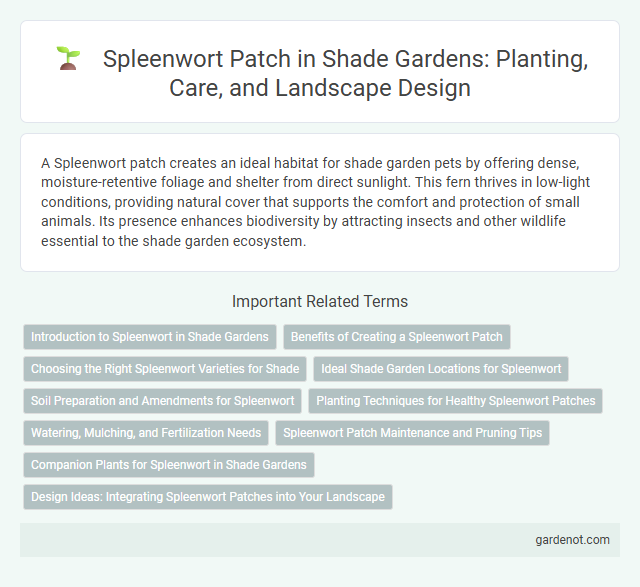A Spleenwort patch creates an ideal habitat for shade garden pets by offering dense, moisture-retentive foliage and shelter from direct sunlight. This fern thrives in low-light conditions, providing natural cover that supports the comfort and protection of small animals. Its presence enhances biodiversity by attracting insects and other wildlife essential to the shade garden ecosystem.
Introduction to Spleenwort in Shade Gardens
Spleenwort (Asplenium spp.) thrives in shade gardens due to its preference for low-light, moist environments, making it an ideal ground cover under trees and in woodland settings. This delicate fern features finely textured fronds that add a soft, lush green layer, enhancing the visual appeal and biodiversity of shaded garden areas. Its resilience to varying soil conditions and minimal maintenance requirements make spleenwort a valuable component in sustainable, shade-loving plant collections.
Benefits of Creating a Spleenwort Patch
Creating a spleenwort patch enhances shade garden biodiversity by providing a natural habitat for various insects and small wildlife. Spleenwort ferns improve soil quality through their deep root systems, which help prevent erosion and retain moisture in shaded areas. Their low-maintenance growth and attractive foliage add year-round aesthetic appeal, making them an excellent choice for sustainable, understory planting.
Choosing the Right Spleenwort Varieties for Shade
Selecting spleenwort varieties suited for shade involves prioritizing species like Asplenium trilobum and Asplenium scolopendrium, known for their robust shade tolerance and adaptability. Opting for cultivars with varying frond textures and colors, such as the dark green fronds of Scolopendrium or the delicate lacy appearance of Asplenium trichomanes, enhances visual interest in shaded garden patches. Ensuring optimal soil moisture and organic matter supports healthy growth and vibrant foliage in low-light environments.
Ideal Shade Garden Locations for Spleenwort
Spleenwort thrives in shaded garden areas with consistent moisture and well-drained, rocky or sandy soil rich in organic matter. Ideal locations include north-facing slopes, woodland understories, and shaded rock gardens where dappled sunlight filters through. These environments mimic spleenwort's natural habitat, promoting healthy frond growth and spore reproduction.
Soil Preparation and Amendments for Spleenwort
Spleenwort thrives in well-drained, humus-rich soil with a pH between 6.0 and 7.5, making organic matter incorporation essential for optimal growth. Mixing aged compost or leaf mold into the soil enhances moisture retention and nutrient availability, crucial for this fern's delicate root system. Incorporating a balanced, slow-release fertilizer high in nitrogen and potassium supports steady foliage development in shaded garden environments.
Planting Techniques for Healthy Spleenwort Patches
Choose a well-drained, humus-rich soil with partial to full shade to ensure optimal growth for spleenwort patches. Space ferns about 6 to 12 inches apart to accommodate their root expansion and maintain proper air circulation. Regularly mulch with organic material like leaf mold to retain moisture and protect the delicate root system from temperature fluctuations.
Watering, Mulching, and Fertilization Needs
Spleenwort patches thrive in consistently moist, well-drained soil, requiring regular watering that maintains dampness without waterlogging the roots. Applying organic mulch such as leaf litter or bark chips helps retain soil moisture, regulate temperature, and suppress weeds around the ferns. Fertilization should be minimal; a balanced, slow-release fertilizer administered in early spring supports healthy growth without overwhelming the delicate root system.
Spleenwort Patch Maintenance and Pruning Tips
Spleenwort patch maintenance involves regularly removing dead or damaged fronds to promote healthy growth and improve air circulation, reducing the risk of fungal infections. Pruning should be done in early spring, carefully trimming back old foliage close to the base without damaging new shoots. Consistent moisture and well-drained soil also support optimal spleenwort development in shade garden settings.
Companion Plants for Spleenwort in Shade Gardens
Spleenwort thrives in shade gardens alongside ferns such as Christmas fern and maidenhair fern, which share similar moisture and light requirements. Hostas and coral bells provide contrasting foliage textures and enhance the visual appeal without competing for nutrients. Adding astilbes and foamflowers promotes a diverse understory, supporting soil health and maintaining the microclimate essential for spleenwort growth.
Design Ideas: Integrating Spleenwort Patches into Your Landscape
Incorporate spleenwort patches into shady garden areas by planting them along rock edges or beneath trees to highlight their delicate fronds and textured foliage. Use varying species of spleenwort to create layered visual interest and complement other shade-loving plants such as hostas and ferns. Position these patches where moisture is retained for optimal growth, enhancing the natural woodland aesthetic of the landscape.
Spleenwort patch Infographic

 gardenot.com
gardenot.com